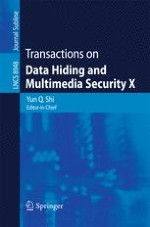2015 | OriginalPaper | Buchkapitel
IR Hiding: Use of Specular Reflection for Short-Wavelength-Pass-Filter Detection to Prevent Re-recording of Screen Images
verfasst von : Isao Echizen, Takayuki Yamada, Seiichi Gohshi
Erschienen in: Transactions on Data Hiding and Multimedia Security X
Verlag: Springer Berlin Heidelberg
Aktivieren Sie unsere intelligente Suche, um passende Fachinhalte oder Patente zu finden.
Wählen Sie Textabschnitte aus um mit Künstlicher Intelligenz passenden Patente zu finden. powered by
Markieren Sie Textabschnitte, um KI-gestützt weitere passende Inhalte zu finden. powered by
